Animation Display: Interior Panoramic View of the HP 405AR


 |
400A Electronic Voltmeter
|
The first HP Electronic Voltmeter was designed by Dave Packard in 1942.
Here is a summary of its characteristics from the 1945 catalog:
"The HP Model 400A Vacuum Tube Voltmeter is unusually flexible because of its wide frequency and voltage ranges. AC Voltages as small as .005 and as high as 300 volts can be simply and directly measured without any precautions over a frequency range of 10 cycles to 1,000,000 cycles. Accuracy of readings is assured because the high 1 megohm input impedance does not disturb the usual circuit under test. Furthermore, the calibration error of the instrument under all conditions is less than 3 % to 100 Kc and less than 5 % to one megacycle."
The 400A service manual is the oldest HP original document of our collection. It is a 7 pages RONEO document with the schematic diagram handmade on the drawing board and dated 7/28/44. (note that the picofarad value of small capacitors was labeled µµf at this time.)
| HP400A Wiring Diagram - Scan of original and oldest service manual in the collection - Dated 1944 |
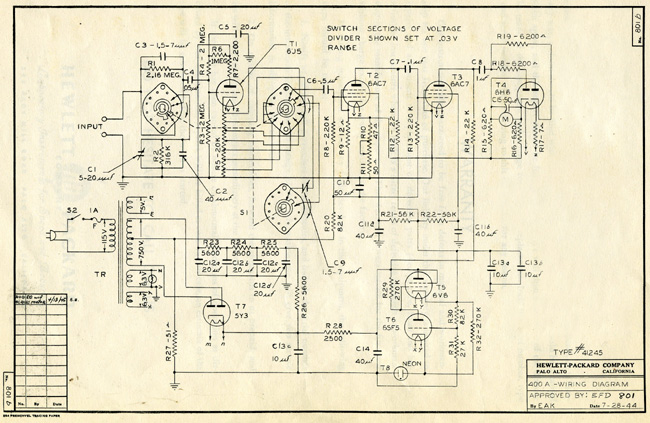 |
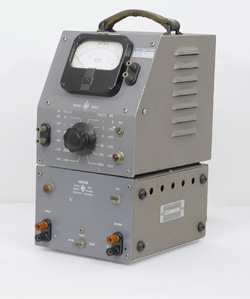 |
The HP 400C and 450A Amplifier
|
The 400C upgrade in 1950 extended the usable frequency range to 2 Mc and the sensitivity to 1 millivolt full scale.
Further improvement of the sensitivity can be obtained with the 450A amplifier introduced in the 1948 catalog. The 450A can be used as a stand-alone general purpose amplifier or as a companion for the 400A or 400C Voltmeters. The 450A has a switchable gain of 20 or 40 dB. Used in conjunction with the 400A voltmeter for example, it will increases the sensitivity 100 times at 40 dB gain for a final 300 microvolts full scale.
As shown in the photo to the right, both amplifier and voltmeter have identical base sizes so they can be stacked to reduce the bench space occupied.
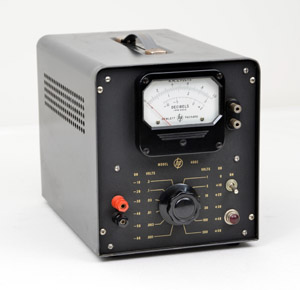 |
Another HP 400C Electronic Voltmeter in the HP Memory Project Collection |
Collecting vintage instruments, as we do, often leads to surprises. One expects to see HP electronic voltmeters from the early years, before the introduction of standardized cabinets, to have sloping panels or narrow wrap-around bezel designs.
But it seems that the HP 400C was produced in several different cabinet styles and front panel layouts. This instrument, shown on the left, in our collection, not only has a different cabinet design, and wider configuration, but it is painted in black, very much unlike all similar years' offerings. Perhaps it was a custom job, for some customer lab that liked black.
The picture below shows Bill Hewlett leaning on one more different case style which was produced in 1952. But none of these different case style, other than the original inclined front panel, were pictured in any HP catalog.
| Bill Hewlett and Dave Packard in 1952 |
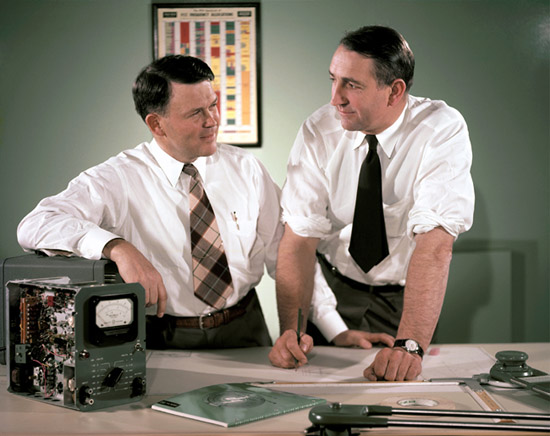 |
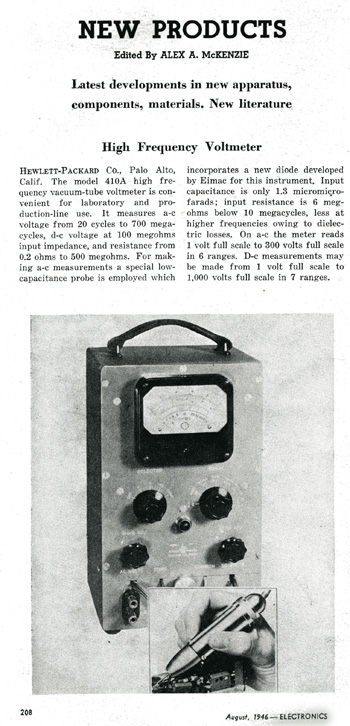 |
410A RF Electronic Voltmeter Introduction
ELECTRONICS Magazine August 1946 |
On the left is an article from the August, 1946 ELECTRONICS magazine introducing the HP410A, HP's first high frequency electronic voltmeter.
A specially-designed diode, in combination with the HP probe design, makes the exceedingly flat frequency response from 20 cps to 700 Mc of the 410A possible.
With this flat frequency response are combined the factors of low input capacity and high input resistance. The input resistance and reactance are high throughout the entire range of the instrument, and thus measurements are made without appreciable detuning or loading of the circuit.
In addition to making UHF radio measurements swiftly and accurately, the 410A is a convenient voltage indicator up to 3000 Mc.
The diode developed by EIMAC for this instrument was certainly the first example of an outside specially-designed component for an HP product and demonstrated the need to create components which was the first sign of the need to create components not yet on the market for the design of innovative instruments. The fact that HP continued to develop such new components of their own can be considered as the origin of the HP components division.
More interesting information about the 410A story can be found on the Southwest Museum of Engineering, Communications and Computation Web Site at:
From the home page, choose chapter: Hewlett-Packard, the Early Years -then- Hewlett-Packard the Start -2 and go to "The 410A Voltmeter is born!". Many comments from Bill and Dave regarding the early R&D at HP are listed on this site.
| HP410A of the Collection with Probe Open Showing the EIMAC Diode |
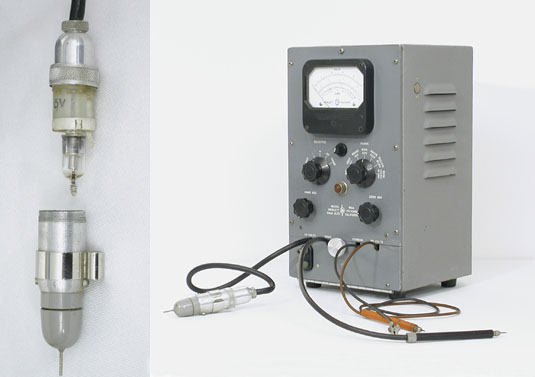 |
| HP410A Probe details emphasis - ELECTRONICS Magazine June 1948 - Page 25 |
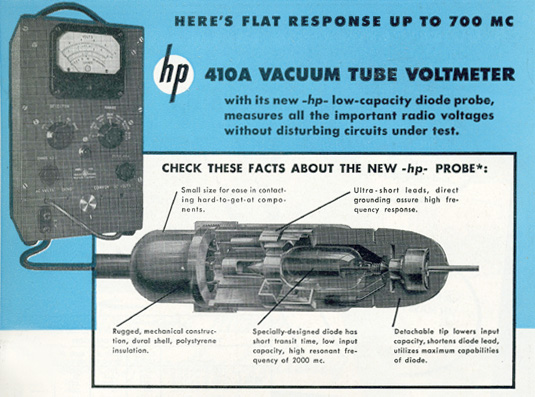 |
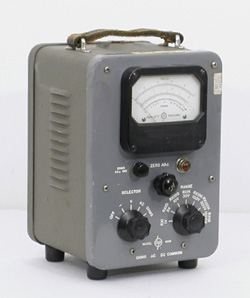 |
410B Electronic Voltmeter
|
The 410B was introduced in the 1952 catalog page 36. It is an interesting example of the constant concern of product evolution at HP. The electrical specifications of the 410B are almost the same as those of the 410A.
But even if technological evolution does not offer the possibility to improve the electronic performance of an instrument many other reasons can generate a newer version of a previous concept. The improvement in the 410B resides mostly in the cabinet design and in the ease of use. Reducing the size and weight makes the 410B a more portable instrument than the 410A. Access to the probe and accessories from a front panel door on the 410A were changed to a rear dedicated compartment which gave a quick and easy setup of the voltmeter when on site usage was required.
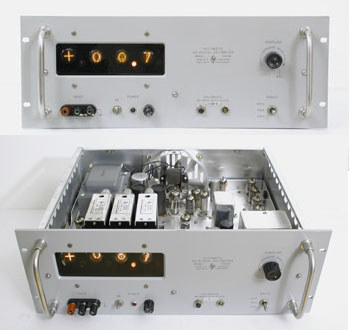 |
The HP 405AR - Still Working today
Front panel and Inside view of the collection unit |
The last addition to the voltmeter product line before the end of the 50s, the 405AR was the first HP digital voltmeter and most of all, it was the first voltmeter introducing the concept of automatic data logging of results for repetitive tests.
The 405AR measurement range is from 1 millivolt to 999 volts positive or negative with automatic selection of range and polarity. Accuracy is within +/- 0.2 % of reading +/- 1 count. Input impedance is 11 megohms on all ranges.
Interesting performance characteristics to compare to modern sampling voltmeter are the ranging time: 1/5 second to 2 seconds depending on range change required - The sample rate: 4 to 5 per second maximum - And the response time: Appoximately 1 second to step function.
Even if modest, these capabilities would trigger the concept of digital data logging and automated testing that would considerably reduce the time for production line testing and calibration and nearly eliminate the risk of human error.
The following improvements would come in about six years and would add the ability to manipulate the data before use. It would be the birth of calculators and the beginning of data automation.

|
Use your scrollwheel to zoom in/out |
|
|
|
Under Chassis Wiring of the HP 405AR |
| 405AR First HP Automatic Digital Voltmeter at work - Page 4 of Hewlett-Packard Journal - January 1959 Copy by permission of the Hewlett Packard Company |
 |